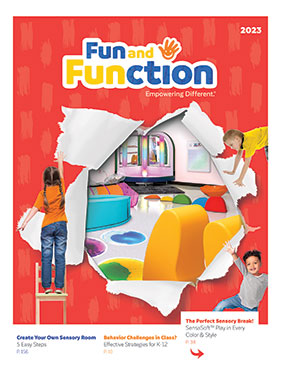Splashdown! Camp is in full swing and homework is long forgotten. For children with special needs summer offers a plethora of opportunities. Summer activities provide outlets to master skills outside of the classroom. Let’s take a closer look at our top 10 favorite summer activities for kids with autism or other sensory processing disorders:
1. Family game night
Game night teaches social skills, turn-taking, focus, how to lose, how to win, and improves attention. Pull out your favorite board game or get more active with a fun activity like our Foam Zip Ball. If you have many people playing, start a game of Hot Potato with a set of bean bags!
2. Take a hike
An outdoor hike provides auditory, visual, tactile, and olfactory input. In the summer, morning and evening hikes are best to avoid the heat. Walk along a creek or to a waterfall for even more sensory stimulation!
3. Build a sensory cave
Grab all your blankets and create your own sensory cave! Fill it with soft pillows and use flashlights for cozy lighting. Turn it into a storytelling adventure and take turns guarding your ‘cave’ against the elements.
4. Go to the beach
The beach provides a plethora of sensory sights and sounds. In addition, you have the benefit of sand play. Practice gross motor skills as you dig in the sand and carry buckets of water from the ocean. Bury yourself in the sand for refreshing deep pressure input!
5. Chef night
Summer is a great time to make a smoothie, favorite cake, or new dinner creation. Let your kids get involved. They can help read directions, shop for ingredients, measure, mix and cook. This helps them work on fine motor and practical life skills, as well as enjoy the end process more!
6. Hit the pool
The resistance and tactile input provided by swimming can help normalize tone, increase muscle strength and coordination, improve respiration, and normalize sensory integration. If your child is hesitant, try sitting on the side of the pool or playing near the water to start. If you can find an occupational or physical therapy program that combines water/pool with land therapy, then you're in luck!
7. Tell a story
Pick a summer reading book and read it out loud together. Take turns reading to practice language skills. What do your kids like about the book? What’s their favorite part? How could it have ended differently? For added sensory input, use interactive books!
8. Have a hug session
Give your kids the attention and deep pressure they crave with a hug session. Wrap your kids up in a blanket and make them into a "hot dog." The deep pressure input can be very calming for kids with autism or sensory processing disorder, especially when their usual school routine has ended and they need to get used to a new schedule.
9. Make recycled art
Take toilet paper rolls, plastic tops, lids, and old magazines along with leaves or sticks from outside. Glue them onto a board or piece of paper for a fun art night. Let your kids get messy and enjoy the textural experience of creating their own artwork.
10. Play in the rain
Wet clothing is a great sensory experience for children with sensory processing challenges. You can also put on their swimsuits or use an umbrella. Smell the difference in the air. Walk-in a stream of water. Taste the raindrops as they fall.
Check out our collection of outdoor play equipment.
What are your favorite summer activities? We’d love to hear! Share them in the comments and we’ll update our list of things to do.
This post was originally posted on 06/23/2014 . It was updated for accuracy and comprehensiveness on 06/14/2022.






























Comments